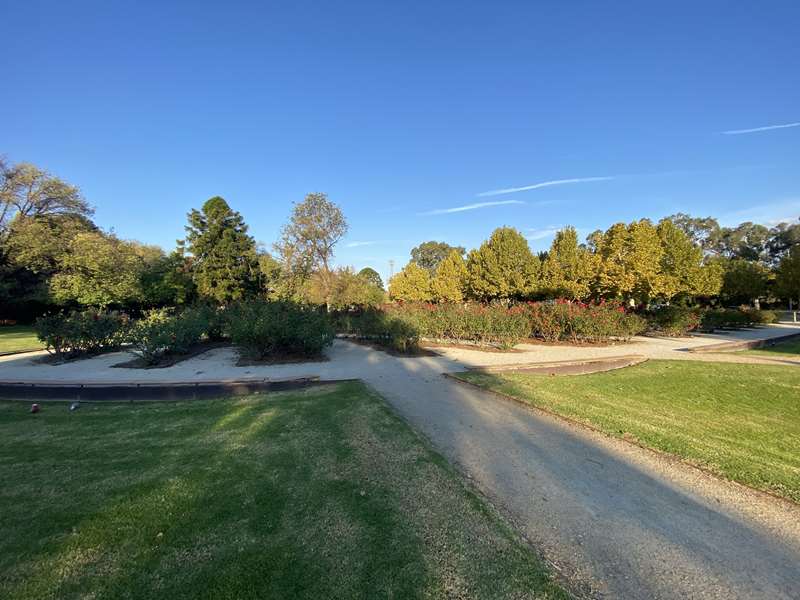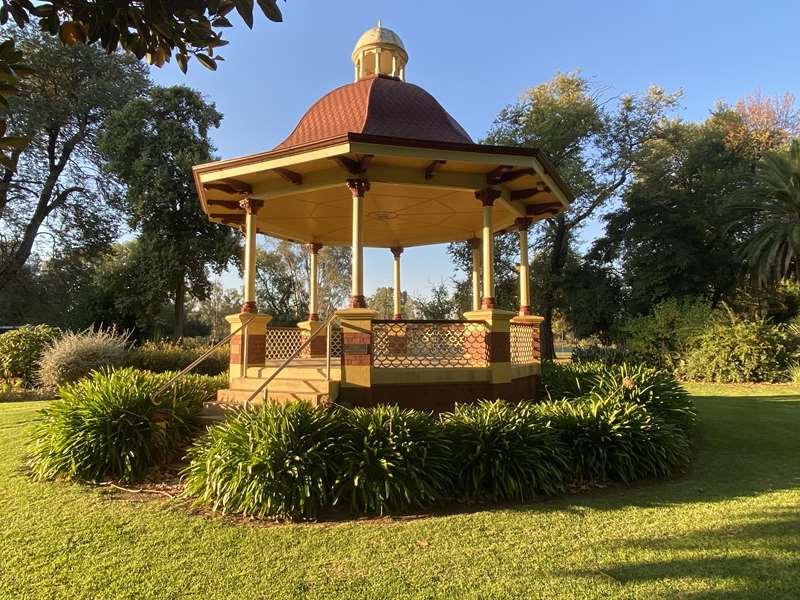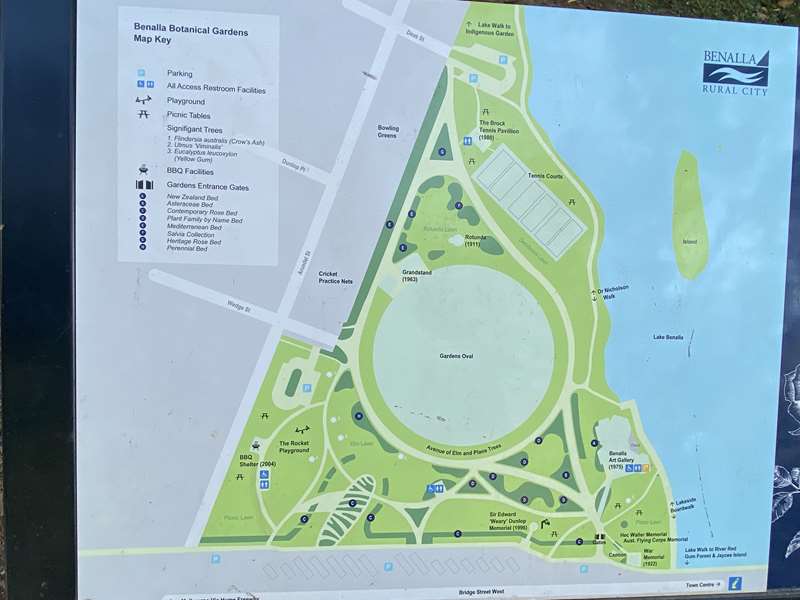Benalla Botanical Gardens


The Benalla Botanical Gardens were designed and developed in 1886 by Alfred Sangwell and were listed on the Register of the National Estate in 1995. They are significant because much of their original layout remains intact and are notably unusual for their combination of ornamental gardens. A double row of elm and place trees surround what is commonly described as the most picturesque cricket oval in the country.
The Rose Garden, first established in 1959, is an icon in Benalla. Rose fanciers will find a notable collection of modern varieties, including Australian roses, seldom found in public gardens.

Extensive lawns sweep down to Lake Benalla, creating an open parkland beneath the trees, which were part of the original planting. Wide curving pathways meander through beds of shrubs and perennial plantings.
The Gardens connect to the Lake Benalla Walk which traverses 4.2 kilometres of diverse and picturesque landscapes including remnant river red gum forest and the Indigenous Community Gardens.

There are toilets, water tap and picnic tables in the garden.
Map of Benalla Botanical Gardens

Sir Edward 'Weary' Dunlop Memorial

A moving sculpture commemorates soldier-surgeon and Australian war hero Sir Edward 'Weary' Dunlop. As a prisoner of war during World War II in Singapore, Sir Dunlop worked as a doctor, saving men from the harsh conditions of camp life. The sculpture depicts Weary stooping over the stricken figure of a POW, shoring up his failing strength, whilst a second doctor administers care.
Hec Waller Memorial
A granite monument commemorates Captain Hector 'Hec' Waller who served during both World Wars. It is also a tribute to all men and women lost at sea on operational service.

Captain Hec Waller DSO, RAN (1900-1942) remains one of the Royal Australian Navy's most celebrated former officers. He was born, bred and educated in Benalla before attending the Royal Australian Naval College in Jervis Bay where he graduated top of his class in 1918 and was awarded the Kings Medal.
He served in both World Wars and reached the rank of Commander in 1934. At the start of World War II, Hec was captain of the destroyer HMAS Stuart and was ordered to take three other Australian destroyers to join the British Mediterranean Fleet.
At the outbreak of hostilities in the Mediterranean, these destroyers and four British destroyers were formed into the 10th Destroyer Flotilla under Waller's command, at which time he was promoted Captain.
For the next sixteen months, Captain Waller distinguished himself as he led these destroyers in a number of actions in the Eastern Mediterranean: the Battles of Calabria, Matapan, the evacuations of Greece and Crete, the re-supply of the Tobruk garrison, all under constant submarine threat and air attack. For his outstanding leadership and bravery, Hec was awarded two DSOs and two Mentions in Dispatches before being recalled to Australia for posting as Captain of the cruiser HMAS Perth in October 1941.
He was posthumously awarded a third Mention in Dispatches following the loss of the Perth and three hundred and fifty-three of her crew in a fierce night action with a greatly superior Japanese invasion fleet in the Java Sea near the Sunda Strait on the 1st March 1942.
The Memorial has been erected to honour Hec Waller in his home town to pay tribute to his courage, leadership and sacrifice, and to the memory of all men and women lost at sea while on operational service.
Among the many tributes written about Waller, two are on the memorial and three others are:
From A Sailor's Odyssey' by Admiral of the Fleet Lord Cunningham.
'Captain Hector MacDonald Laws Waller will always remain in my mind as one of the very finest types of Australian Naval Officer. Full of good cheer, with a great sense of humour, undefeated and always burning to get at the enemy, he kept the old ships of his flotilla... hard at it always. Greatly loved and admired by everyone, his loss in HMAS Perth in the Java Sea in 1942 was a heavy deprivation for the young Navy of Australia'.
From L. E. Clifford, book 'The Leader of the Crocks'
'Commander Waller was the type of man in whom one could have complete confidence in an emergency...'
From Arthur Bancroft's book 'The Mikado's Guests'
He certainly created a legend in the first two years of the war'.
The concept for the Memorial includes several features. Natural rock was used to emphasise Captain Waller's qualities - strong, reliable and unpretentious. The best colour was found in the Beechworth granite made available by Indigo Shire Council. The 'swirl' sculpted by Louis Laumen depicts the disturbance made by a ship just after sinking below the water, while the caps and Remembrance Poppies are a reminder of lives lost at sea. The bas-relief of Hec was also sculpted by Louis Laumen.
Photos:
Location
1 Bridge Street West, Benalla 3672 Map
Web Links
→ Benalla Botanical Gardens walk (Walking Maps)
→ Benalla Botanical Gardens Accessible Walk (Walking Maps)









